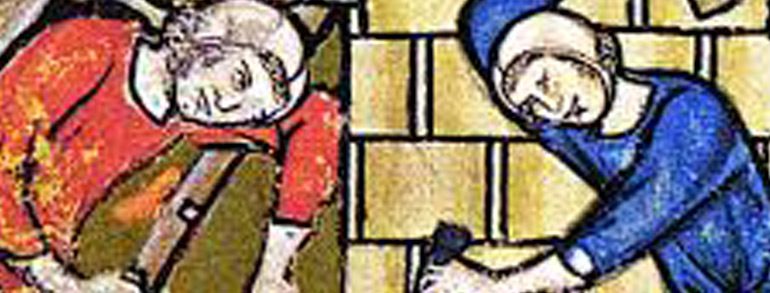By Russell Herner, PDDGM
For centuries, during the Middle Ages of Europe, the Master Masons conducted apprenticeship schools to teach the young apprentices the craft of stonemasonry and ‘The Art of Geometry’. The apprenticeship training program was very intense and completed over several years of hard work and study. It was a combination of both practical (hands-on stonemasonry), as well as theoretical (architectural and engineering) training. The training included educating young men in the craft of stonemasonry, liberal arts, sciences, communication skills, and especially geometry.
Geometry and Masonry were synonymous terms in the stonemason's training program. Geometry and building craft secrets were passed down through the generations by word of mouth in the program. The stonemason schools were certainly the top-notch schools of the day.
Bright young men in their early teens, who showed potential for learning and demonstrated good manual skills, were selected to enroll in the apprenticeship program. The Master Mason and apprentice’s parent signed an official document called an indenture (contract) that confirmed the Master Mason would train the apprentice in the stonemason's craft. It specified the number of years of the agreement and bound both parties to a set of disciplined work rules and conduct.
Note, not all of the stonemason apprentice students that were selected continued in the program, but rather stopped when the requirements of the program exceeded the skill level of each Mason. The Masons then continued working on the project at their own skill levels.
The operative stonemason apprenticeship program was a system of three degrees. The plain Apprentice degree required one year of training, the Entered Apprentice three years of training, and the traditional Fellow of the Craft/Master Mason degree seven years of training. Upon completion of his demanding eleven- year apprenticeship training program, the Master Mason could take on stonemasonry projects of his own, or it was customary for him to go on a Journeyman’s tour for an additional three years of training to other cathedral or major construction sites.
The Journeyman’s tour was also called Wanderyears or Wanderjahrs in German. On this tour he would visit cathedrals in his own country, as well as foreign countries, to observe the most up-to-date design techniques being used. These visits greatly broadened his knowledge base and provided him with new ideas for future projects. After fourteen years of intense apprenticeship training, coupled with experience and observation from other major cathedral structures, the Master Mason was then well equipped to take on a building commission of his own. After a Master Mason received a commission to design and build his first major project such as a cathedral, he essentially became a “Master Builder”. Not surprisingly, the graduate Master Masons from the apprenticeship schools were some of the most highly educated people in the community at that time. The Master Builder’s brilliance is reflected in the magnificent European Cathedrals!
A cathedral is a work of art, and the Master Builder, in an amazing display of talent, designed and constructed the cathedrals with a mission to replicate heaven on earth, and to please God in every small detail. He was the architect, general contractor, engineer, artist, sculptor, surveyor, draftsman, teacher of the apprentices, and supervisor of the craftsman. He was generally literate in English, French, and Latin, which allowed him to travel from country to country to different building sites and properly communicate architectural and stonemasonry construction techniques with other masters, craftsman, bishops, and patrons. He was a highly educated professional architect, influential in the community, and enjoyed the respect and esteem of his peers. The Master Builders were brilliant and were the cream of the craft.
The Master Masons and Master Builders were essentially the early school teachers and professors of the stonemason students in the apprenticeship schools during the Middle Ages. I maintain the stonemason apprenticeship schools played a very big role in the early formal educational systems in Europe.

